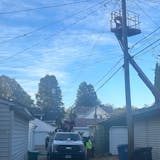Amanda Baumann is a pro.
She doesn't go to a thrift store without filling her vintage leather Coach backpack with the essentials: spray hand sanitizer (lavender-scented); a measuring tape; a few reusable nylon tote bags; headphones; store member cards and coupons; a snack and some gum.
"It can be overwhelming at first," she said. "But I think you just need to take your time: aisle by aisle, rack by rack. Think of it as a treasure hunt. Put on your headphones, listen to your favorite music, and get lost in the hunt."
That's what Baumann does, sometimes at 10 stores a day, when she's thrifting — searching for gems amid stuffed racks of used clothing and housewares she then sells through her Tandem Vintage business.
Right now, Baumann is looking for fabrics such as linen and cotton, dresses in floral prints and high-waisted denim.
At the Savers in Columbia Heights, she recently grabbed a Gap jacket from the 1990s (now considered vintage) and a pair of pleated jeans in a black acid wash. "Straight out of 'Saved by the Bell,' " she said, referencing the sitcom.
That's what her customers are looking for, especially the many college students who frequent her shop inside the Findfurnish storefront in northeast Minneapolis.
"I love the fact that I am saving these pieces from the landfill," said Baumann, who left her job in communications five years ago to run Tandem Vintage full-time. "I love that I am not supporting fast fashion. I feel good knowing that I am doing a small part to keep these pieces in rotation by helping them find new homes and new closets."


